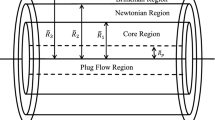Abstract
In this paper, we discussed a mathematical model for two-layered non-Newtonian blood flow through porous constricted blood vessels. The core region of blood flow contains the suspension of erythrocytes as non-Newtonian Casson fluid and the peripheral region contains the plasma flow as Newtonian fluid. The wall of porous constricted blood vessel configured as thin transition Brinkman layer over layered by Darcy region. The boundary of fluid layer is defined as stress jump condition of Ocha-Tapiya and Beavers–Joseph. In this paper, we obtained an analytic expression for velocity, flow rate, wall shear stress. The effect of permeability, plasma layer thickness, yield stress and shape of the constriction on velocity in core & peripheral region, wall shear stress and flow rate is discussed graphically. This is found throughout the discussion that permeability and plasma layer thickness have accountable effect on various flow parameters which gives an important observation for diseased blood vessels.









Similar content being viewed by others
References
Beavers, G.S., Joseph, D.D.: Boundary conditions at a naturally permeable wall. J. Fluid Mech. 30(1), 197–207 (1967)
Boodoo, C., Bhatt, B., Comissiong, D.: Two-phase fluid flow in a porous tube: a model for blood flow in capillaries. Rheol. Acta 52(6), 579–588 (2013)
Brinkman, H.C.: Experimental data on the viscous force exerted by a flowing fluid on a dense swarm of particles. Appl. Sci. Res. A 1(1), 27–34 (1947)
Brinkman, H.C.: On the permeability of media consisting of closely packed porous particles. Appl. Sci. Res. 1(1), 81–86 (1949)
Chakravarty, S., Datta, A.: Pulsatile blood flow in a porous stenotic artery. Math. Comput. Modell. 16(2), 35–54 (1992)
Dash, R., Mehta, K.: Casson fluid in a pipe filled with a homogeneous porous medium. Int. J. Eng. Sci. 34(10), 1145–1156 (1996)
Dash, R.K., Mehta, K.N., Jayaraman, G.: Effect of yield stress on the flow of a Casson fluid in a homogeneous porous medium bounded by a circular tube. Appl. Sci. Res. 57, 133–149 (1997)
Ehrhardt, M.: An introduction to fluid-porous interface coupling. Angewandte Mathematik und Numerische Mathematik, 1–10 (2010)
Goharzadeh, A., Saidi, A., Wang, D., Merzkirch, W., Khalili, A.: An experimental investigation of the brinkman layer thickness at a fluid-porous interface. In: IUTAM Symposium on One Hundred Years of Boundary Layer Research, pp. 445–454 (2006)
Haldar, K., Anderson, H.I.: Two-layered model of blood flow through stenosed arteries. Acta Mech. 117, 221–228 (1996)
Hill, A.A., Straughan, B.: Poiseuille flow in a fluid overlying a porous medium. J. Fluid Mech. 603, 137–149 (2008)
Khaled, A.R.A., Vafai, K.: The role of porous media in modeling flow and heat transfer in biological tissues. Int. J. Heat Mass Transf. 46(2003), 4989–5003 (2003)
Mckinley, R .M., Jahns, H., Harris, W .W.: Non Newtonian flow in porous media. A.I.Ch.E. J. 12(1), 17–20 (1966)
Mehmood, O.U., Mustapha, N., Shafie, S.: Unsteady two-dimensional blood flow in porous artery with multi-irregular stenoses. Transp. Porous Media 92, 259–275 (2012)
Misra, J.C., Sinha, A., Shit, G.C.: Mathematical modeling of blood flow in a porous vessel having double stenoses in the presence of an external magnetic field. Int. J. Biomath. 04(02), 207–225 (2011)
Muskat, M.: The flow of fluids through porous media. J. Appl. Phys. 8, 274–282 (1937)
Nield, D.A.: The boundary correction for the Rayleigh-Darcy problem : limitations of the Brinkman equation. J. Fluid Mech. 128, 37–46 (1983)
Ochoa-Tapia, J.A., Whitakeri, S.: Momentum transfer at the boundary between a porous medium and a homogeneous fluid I. Theoretical development. Int. J. Heat Mass Transf. 38(14), 2635–2646 (1995)
Odeh, A.S., Yang, H.T.: Flow of non-Newtonian power-law fluids through porous media. Soc. Pet. Eng. AIME 7139(June), 155–163 (1979)
Ponalagusamy, R.: Blood flow through an artery with mild stenosis: a two layered model with different shapes of stenosis and slip velocity at wall. J. Appl. Sci. 7(7), 1071–1077 (2007)
Ponalagusamy, R., Selvi, T.R.: A study on two-layered model (CassonNewtonian) for blood flow through an arterial stenosis: axially variable slip velocity at the wall. J. Frankl. Inst. 348, 2308–2321 (2011)
Pries, A.R., Secomb, T.W., Gaehtgens, P.: Biophysical aspects of blood flow in the microvasculature. Cardiovasc. Res. 32(1996), 654–667 (1996)
Sacheti, N.C., Chandran, P., Khod, A., Oman, S.: Steady creeping motion of a liquid bubble in an immiscible viscous fluid bounded by a vertical porous cylinder of finite thickness. Adv. Stud. Theor. Phys. 2(5), 243–260 (2008)
Sankar, D., Lee, U.: Two-fluid Casson model for pulsatile blood flow through stenosed arteries: a theoretical model. Commun. Nonlinear Sci. Numer. Simul. 15(2010), 2086–2097 (2010)
Sankar, D.S.: A two-fluid model for pulsatile flow in catheterized blood vessels. Int. J. Non Linear Mech. 44(4), 337–351 (2009)
Shivakumar, P.N., Nagaraj, S., Veerabhadraiah, R., Rudraiah, N.: Fluid movement in a channel of varying gap with permeable walls covered by porous media. Int. J. Eng. Sci. 24(4), 479–492 (1986)
Shukla, J.B., Parihar, R.S., Gupta, S.P.: Effect of peripheral layer viscosity on blood flow through the artery with mild stenosis. Bull. Math. Biol. 42, 797–805 (1980)
Sochi, T.: Non-Newtonian flow in porous media. Polymer 51(22), 5007–5023 (2010)
Srivastava, V.P., Saxena, M.: Two-layered model of Casson fluid flow through stenotic blood vessels- application to the cardiovascular system. J. Biomech. 27(7), 921–928 (1994)
Straughan, B.: Stability and Wave Motion in Porous Media, vol. 165, 165th edn. Springer, New York (2008)
Tang, H.T., Fung, Y.C.: Fluid movement in a channel With permeable walls covered by porous media: a model of lung alveolar sheet. J. Appl. Mech. 42(March), 45–50 (1975)
Whitaker, S.: Flow in porous media I: A theoretical derivation of Darcy’s law. Transp. Porous Media 1(1), 3–25 (1986)
Acknowledgements
Bhupesh Dutt Sharma was supported by the MHRD Fellowship for Research Scholars administered by MNNIT Allahabad.
Author information
Authors and Affiliations
Corresponding author
Appendix A
Appendix A
Rights and permissions
About this article
Cite this article
Sharma, B.D., Yadav, P.K. A Two-Layer Mathematical Model of Blood Flow in Porous Constricted Blood Vessels. Transp Porous Med 120, 239–254 (2017). https://doi.org/10.1007/s11242-017-0918-9
Received:
Accepted:
Published:
Issue Date:
DOI: https://doi.org/10.1007/s11242-017-0918-9




